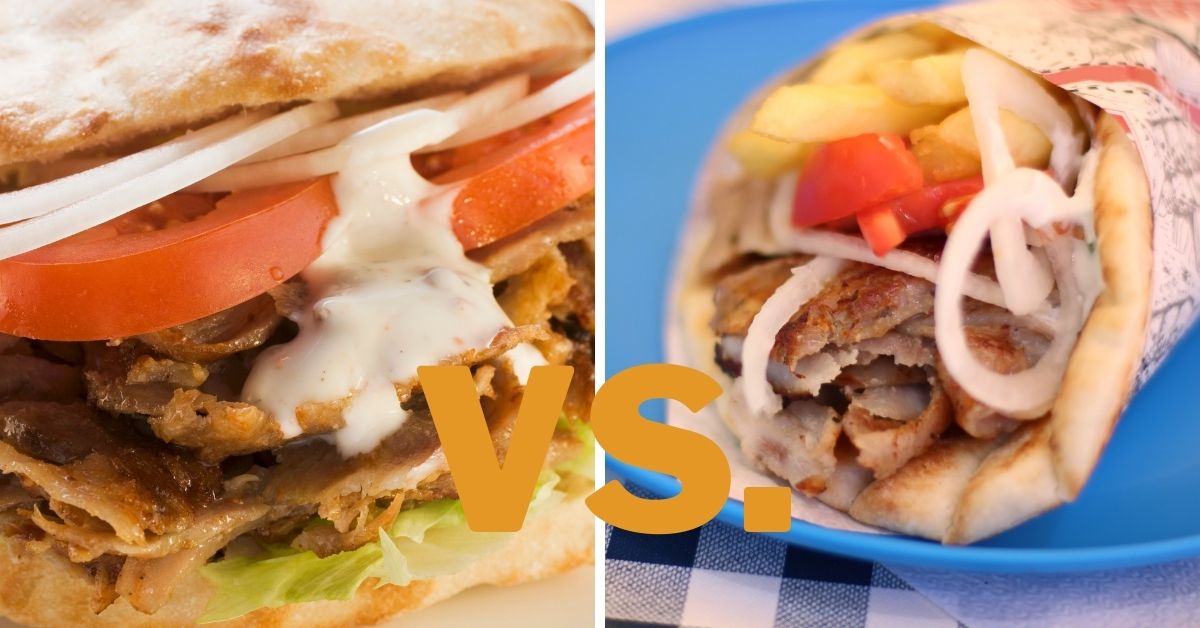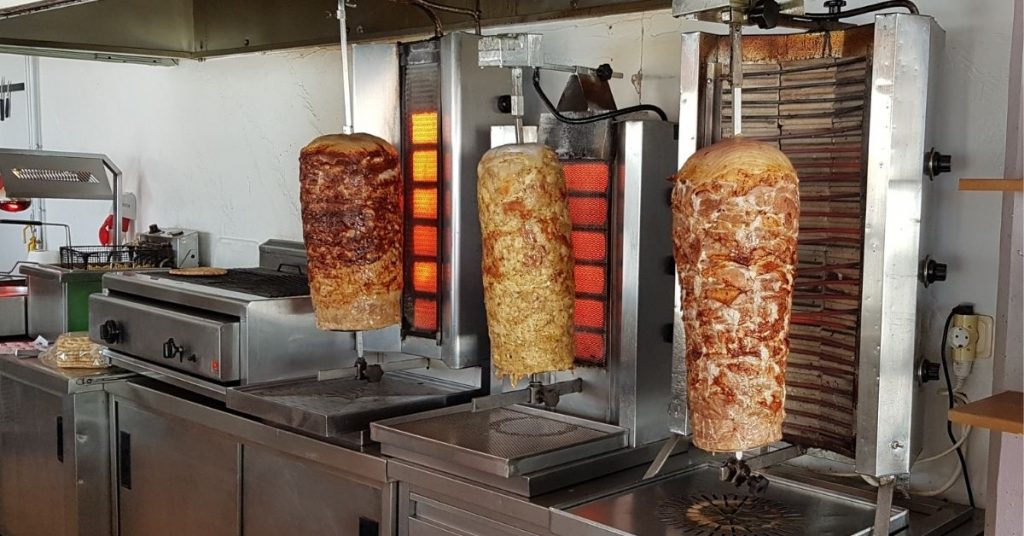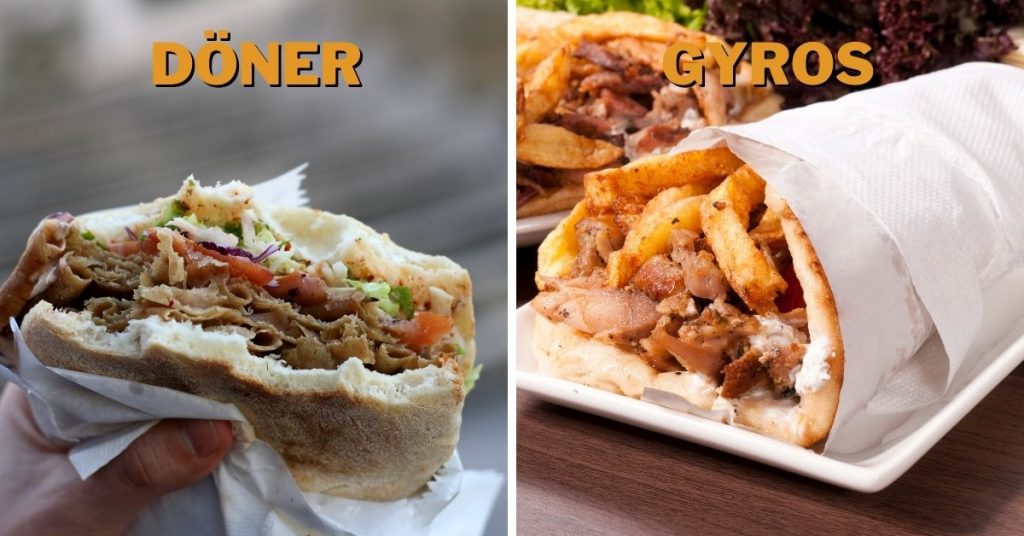Döner vs. Gyros: Differences & Which Is Better?

On the surface, döner and gyros are remarkably similar. This resemblance extends even to the way the meat is cooked: vertically roasted on a spinning spit or rotisserie. But, there are some key distinctions between these two popular fast food dishes. So, how do you differentiate between döner kebab and gyros?
Döner originates from Turkey and it is served in Turkish flatbread. Gyros is a Greek dish served in tortilla-like bread called pita. The meat in gyros is typically lamb or chicken, whereas döner utilizes lamb, beef, and rarely chicken. Another big difference is that gyros has Mediterranean spices, while döner includes spicy Turkish spices.
It is easy to mistake one of these dishes for the other. So, in this article, I discuss the differences between them, as well as the finer clues you can pick up to tell which one is which.
What Is the Difference Between Döner and Gyros?
The main differences between döner and gyros are their countries of origin, ingredients used to make and serve these meals, and spices used to marinate the meat. Here is everything explained in more detail.
Origin
When you trace the inception and inspirations for both these dishes, you can easily understand how they got to be so similar.
The practice of stacking meat in the shape of a vertical cone and cooking it on a spinning spit became popular in the Ottoman Empire around the 1200s. This led to the creation of the döner kebab, and it is still one of the more popular dishes in that region and many places outside of it.
However, Greece was a part of the same Ottoman Empire until the nineteenth century. As such, many dishes in Greek cuisine flourished under the influence of Turkish culture. And this is most evident when you look at the döner and gyros side by side.
But they are not entirely similar. After the Greeks adopted it, the gyros evolved and integrated many elements of Greek cuisine.
Ingredients
The first noticeable difference can be seen in the choice of meat. In döner kebab, the meat you normally find is ground lamb, chicken, or beef.
But in a gyro dish, the meat is typically lamb or chicken. Beef and pork are also used, but they are very rare. Of course, gyros’ reach extended to many parts worldwide, so the type of meat varies depending on the place more than tradition. Furthermore, meat for gyros is not previously minced as it is while preparing döner.
When preparing the meat for döner, people use a Turkish spice mix consisting of cumin, garlic powder, salt, coriander, pepper, oregano and smoked paprika. When you look at this list, you can guess that the mixture can be spicy and has a strong flavor. If you had that in mind, you are not wrong.
On the other hand, gyros meat is more light for your stomach than döner meat because gyros meat is marinated with Mediterranean spices, such as rosemary, oregano and thyme.
The sauce in the döner is a mixture of yogurt and garlic, which has a pretty similar taste and texture to mayonnaise.
The Greek sauce that accompanies most gyros is called tzatziki. It is a type of salted yogurt mixed with garlic, cucumber, and of course, olive oil.
Preparation
The meat cooking process in both dishes is pretty much identical since they both share a similar source of inspiration. Where they differ is the seasoning used to enhance the flavor of the meat.
When preparing döner, we use ground meat, mix it with spices, minced onion and lamb tail fat. After that, we shape the mixture into a roller on the roastery sticks and leave it to chill so that it won’t have a crumbly texture.
In contrast, when you prepare gyros meat, you use thin, flat slices of meat and stack them on top of each other to form an inverted cone. Then the stack slowly spins inside a rotisserie, which cooks the meat from out to in.
When it comes time to serve, the chef slices the meat off from the outer layer and the rest is left on the spit. This step is the same in both cases.

Now, gyros are most often served as a wrap in a similar way to burritos. For this purpose, pita bread is the most commonly used in Greek cuisine. It may remind you of tortillas, only that pita is thicker. You may find that the meat is inside a pocket formed by the pita. Other elements such as sliced vegetables and fried potatoes are also added, with the entire thing is topped with tzatziki.
Döner kebab, on the other hand, can be served in more varied ways. You can serve döner directly on a plate, accompanied by vegetables and fries. Or you can serve it inside a flatbread.

The döner has seen plenty of variations across regions. In Azerbaijan, the meat is wrapped in a type of flatbread known as “lavash.” This is also similar to how they serve döner kebabs in European countries. In France, you can often find döner stuffed inside bread.
Popularity
Both döner and gyros have seen their fame extend to distal parts of the world, far from their native regions. This is mostly thanks to Turkish and Greek immigrants spreading their traditional cuisines to these parts of the world.
Döner is widely popular in Japan, France, Germany, and the United States. Although in many places across the US, döner exists in the form of gyros. For that reason, we can say that gyros is more popular in the US than döner.
Döner Vs. Gyros: Which Is Better?
This ultimately comes down to your personal taste and which flavor profile attracts you the most. The salty, creamy taste of döner sauce and spicy Turkish flavors may persuade you over to that side.
However, if you like the distinct flavor of tzatziki, chicken over the lamb or beef, you may be attracted by gyros more.
One area where döner is a clear winner is in the styles you can serve it. You have much more options when serving a döner, whereas gyros are limited to the inside of pita bread.
So, now you know a little bit more about these two Mediterranean dishes. Hopefully, next time you find yourself at a kebab restaurant, you can spot which dish is which. Either way, you are sure to have a delicious time with two exotic fast food items.
